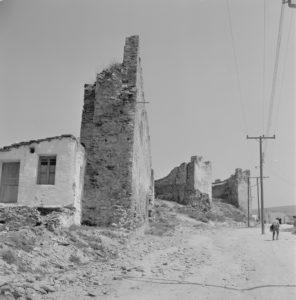The buildings abutting the walls around the acropolis (‘kastroplikta’)
City
Migration Period
City Narratives
Tag
Category
Full Description
Living next to defensive walls is common throughout Greece, with the wall often constituting part of the building structure. Some examples include the Acropolis of Athens in the 19th century, walls and castles on several Aegean islands, such as the castle of Chios where refugees settled after 1922, and the castle of Didymoteicho. However, Thessaloniki remains the most prominent example because of the mass settlement of refugees along a large portion of the city’s extensive walls rather than just adjacent to the castles or the acropolis, as was the case elsewhere.
In fact, in Thessaloniki, there were houses abutting or adjacent to nearly the entire length of the city walls. On the western side, starting from Mouschoudi Square to the Acropolis, houses were built both inside and outside the walls. On the east side, from the building of Islahane to the Tower of Trigonio, houses were built only inside the walls, as can be seen in photographs of the time. Many of these houses still stand, even though most have fallen into disrepair. The most notable wall-abutting houses are the ones in the area around the Acropolis, especially the south side of the northern wall, on Eptapyrgiou Street, where the walls were either immediately adjacent to the houses or constituted a part of the houses themselves.
In the first photograph from 1933, Eptapyrgiou Street (photographed from the middle gate) appears to be densely populated a decade after the arrival of the refugees. Few of these houses still survive. In the next photographs, we can see small, plain dwellings and buildings in the area around the church of Agioi Anargiroi in the 1960s. None of these buildings survives today. In the last photograph, we can make out doors which have been opened in the walls. This spot housed several taverns during the ‘80s and the ‘90s, a boom time for restaurants for this area and the area of Tsinari.
The area around the Agioi Anargiroi church is one of the most popular tourist attractions of Ano Poli, a direct result of promoting the city’s Byzantine past. This promotion was accomplished by showcasing the city’s walls, which was in turn achieved by demolishing the refugee houses that abutted them, reflecting the constant tension and conflict between different pasts and memories.
Bibliography
Nikoleta Chouma and Athanasia Nikolopoulou, Everyday life in Kastroplikta in Salonica, dissertation, National Technical University of Athens, School of Architecture, Department of Architectural Language, Communication and Design, Athens 2018. https://dspace.lib.ntua.gr/xmlui/handle/123456789/46963?show=full





